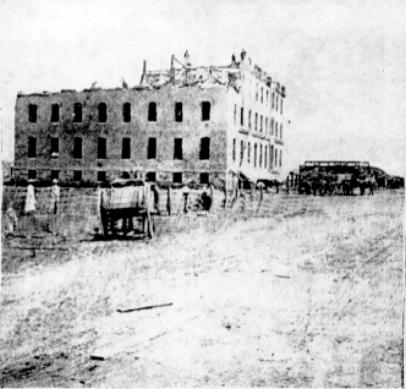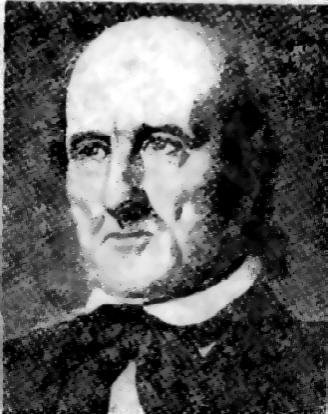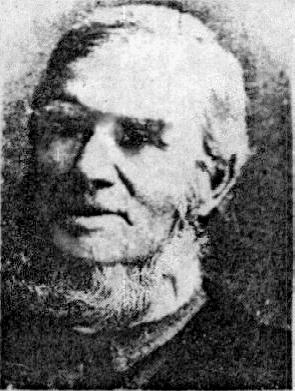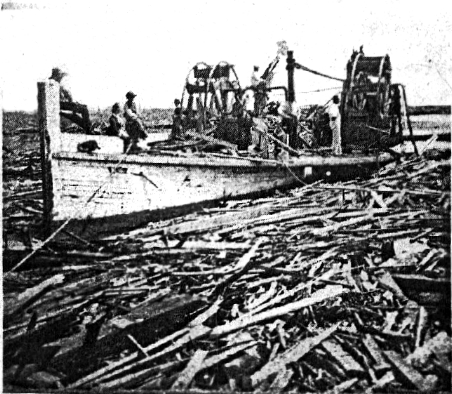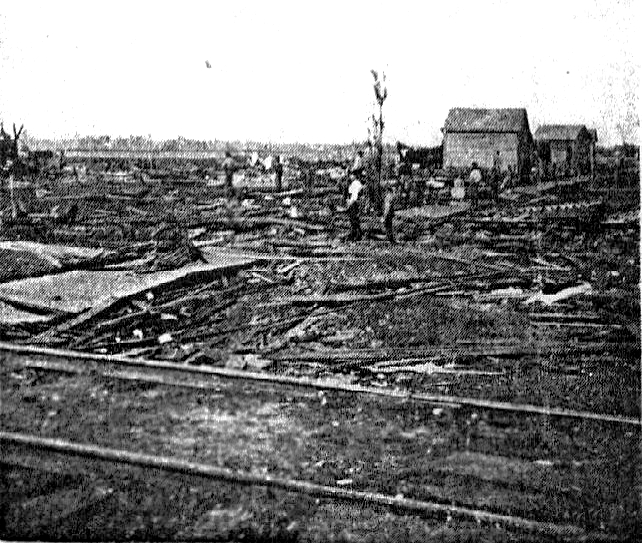| Oconto County Reporter
November 11, 1971 Contributed by Dave Cisler
Pensaukee Rose Like A Comet
Arndt built a new mill in 1837 and continued to operate it – with Oneida Indians as log cutters – until 1848 when H. B. Hinsdale of Kenosha bought the property. At that time, homes for the sawmill workers began to spring up and in a short time Pensaukee (called Paissacue” by the Menominees) became a bustling, prosperous mill town. Offering great competition to mills which had been built in the meantime at Suamico, Oconto, Oconto Falls, Peshtigo and Marinette. About 1849, H. B. Ketcham, E.R. Livermore, Moses Hardwick and others moved to the growing mill town – the same time as John Windross and M. C. DeLano were settling on the shore in Oak Orchard. But it was with the arrival of F. B. Gardner in 1850 to purchase the mill, that Pensaukee really began to get on the map. One of the “grand” things that Mr. Gardner did was to build a hotel that was the envy of townships for miles around. It was a three-story brick structure (in the days when everything was built of timber) and could boast of being the best equipped hotel north of Milwaukee, complete with “modern plumbing and hot and cold running water.” Indeed, it was really something in this still wild backwoods country, with fancy furniture and the best in appointments.
At the height of the logging there were seven dams on the Pensaukee river, with at least three mills operating at one time. As the timber was logged off, more and more people purchased land and began farming on a small scale, logging in winter and clearing land and tilling in summer. A few, like John Windross, gave all their time to their gardens. Besides the lumbering operation, fishing was also a major industry and this brought more families, so that by 1870 it was quite a settlement, complete with schools and churches. The township was hurt by the Peshtigo Fire of 1871 that destroyed much of the timberlands, but there was still no thought that the town would do anything but grow larger and larger. An indication of what the town was like just before the tornado literally wiped it out, can be seen from this description of Pensaukee written by one of the town’s correspondents in 1875 for the Reporter:
“Pensaukee has one of the finest hotels in the state, has no saloons or anything of that kind; consequently, we have a very quiet place. Mr. Gardner is the Kind David of Pensaukee and has now been residing here for some time. He is a very thorough businessman and will make a large manufacturing place of this. He has dredged the river from one end to the other, while a dozen firms at Oconto will not dredge two or three sandbars. Mr. Gardner is ready to do his half of the proposed road on the bay shore if Oconto will do theirs. Mr. Baptist ranks next to Mr. Gardner – about the same as Bismarck to the Emperor of Germany. Next is Mr. Golden. It is hoped that Pensaukee will grow up to be one of the great American cities with its associated city of Oconto. Among our fishermen are Joseph Levaille. William Miller, Charles Windross, George Ross and Henry Pluker. The main gardeners are Joshua Snyder and E.R. Livermore. Livermore beats all for pie plant – five stalks weighted eight pounds – and he harvested 20 bushels of strawberries on his land.” And, in another Reporter article of the same year, we read: “Mr and Mrs. Coleman are doing the hotel business to
perfection and have the gratitude of all the wayfarers who have the pleasure
of stopping at this beautiful resort. Mr. F. Gardner is personally
supervising the working of his extensive lumber interests, with the assistance
of T.F. Snover. The colossal institution includes a machine ship,
a grist and flour mill, planning and shingle mills and a sawmill.
Pensaukee has one of the best harbors on Green bay. It is in every
way a site for a large town, and we opine a bright future for Pensaukee
at no very remote period.”
PENSAUKEE – GONE WITH THE WIND No prophecy could have been more incorrect. Two years later the proud lumbering and fishing town was to be blown into almost total oblivion. Many tales are told of the freak and tragic happenings
of the tornado – of the straw blown through a heavy door; the sewing machine
blown through a cow, and of the young mother whose baby was snatched from
her arms by the fiendish wind and never seen again. The tornado destroyed
the mills, made kindling of all but two or three homes, ripped off whole
sections of the Gardner hotel, and destroyed the ships and lumber in the
harbor.
But contrary to general belief, Pensaukee did not die overnight. Gardner made a noble attempt to restore the town and get it on its feet again, operating a store in the part of the hotel left standing, moving the post office to the depot, and reading a new schoolhouse. The lumbering operation was also started again, and in the August 14 issue of 1880 the Reporter noted: “Business is booming in Pensaukee. Gardner and Baptist are running their mill night and day, three vessels are loading at the port, and a great deal of lumber is being piled in the company’s yard. A car a day of baled sawdust is being shipped to Crystal Lake, Illinois, for ice packing, and the Willington cheese factory is flourishing. The population of Pensaukee township is now 1,419. There are 5,481 acres of cleared land, with 207 farms and 255 dwellings.” By 1882 the township was too large for convenient administration,
and the board of supervisors petitioned to submit the question for election
of dividing it into three townships – Pensaukee, Morgan and Abrams.
Among the families living in Pensaukee township – many of whom came before the Civil War – could be added those of James Bundy, George Birmingham, John Goddard, Edgar and Henry DeLano, Joseph Dodds, Thomas Pillsbury, Bovee, Bowman, Tuttle, Crooks and Powell. * * * But the hope of returning to its former status was to be short lived. With most of the timber gone through wind and fire, and his mill property with it, and his beautiful tourist hotel a shambles, Mr. Gardner apparently gave up on Pensaukee. His big, white home on the south end of town was sold to Mr. Livermore, and he left for his former home in Chicago. There was no boasting in the copy sent by the Pensaukee correspondent to the Reporter in November of 1887, but rather a plaintive cry, voiced in these words: “Everyone is wondering if we are going to have another mill here or not. We are all wishing that a sale of the mill property will be effected and business started up with a rush again. Why can’t it be done? Can’t someone strike a mineral spring or iron mine and boom the town a little?” But Pensaukee was not to boom again. It was to remain a peaceful fishing village with only one notorious event to focus the attention of outsiders on the town again. WHO KILLED BAUMGARTNER? This was the question asked following a murder of Michael Baumgartner in June of 1895, a question to be repeated often over they years to come, and one that still remains unanswered. Following is the story of the shooting as appeared in the Reporter. A LIFE IN EXCHANGE FOR A FEW DOLLARS “Death by the hand of an assassin, remote from scenes to us familiar, produces a shock of but brief duration, but when a respected citizen in our midst is shot down within the sacred portals of his own fireside, a thrill of horror permeates the community. “Last Friday night, about half-past eleven, Michael Baumgartner, for many years a resident of Pensaukee and for the past 17 years engaged in the saloon business, was almost instantly killed at his home by two men who had entered for the purpose of robbery.” A representative of the Reporter called on Mrs. Baumgartner the day of her husband’s funeral and received her story of the crime. Mrs. Baumgartner said she had retired early with her little boy, Willie, and woke to hear her husband say “Come on; there are robbers!” She got up and saw him standing in the door of his bedroom, holding a shotgun in one hand and a revolver in the other. A man, she said, stood in the saloon doorway, aiming a revolver at her husband, and another man was standing in the center of the sitting room. When the second man turned his gun on her, she closed and locked the door. Mrs. Baumgartner said she then jumped out a window and ran for help to the home of Phil McGovern. When she returned, her husband was lying on the floor and the men were gone. A wardrobe, where Mr. Baumgartner was supposed to have kept his money, was broken into. The search for the two men described by Mrs. Baumgartner went on for weeks. Suspects picked up in Green Bay and Appleton, who supposedly fit the description, were brought in, but Mrs. Baumgartner could not identify them positively as being her husband’s killers. Two years later a man appeared in town who took odd jobs and told authorities he could obtain evidence that Mrs. Baumgartner had killed her husband. Neighbors also came forward to say they suspected she knew more about the affair than she had told. There was also the fact that she had given contradictory reports of the tragedy and, on the strength of all this, a warrant was taken out for her arrest. In the end, however, lacking sufficient proof of her
involvement, the woman was released, and the question, “Who killed Baumgartner?”
remained unanswered for all time.
Mr. Duane S. Mc Call
Dear Mr. McCall: Congratulations on the 100th birthday of the Oconto County Reporter. This is a significant event both in the life of the newspaper and of our county. A century of life, and more important, of service to our community surely merits recognition. The pages of the Reporter during this period have documented the week by week history of Oconto County. These pages through the years have told of significant events in the lives of our people and of the county itself. They have chronicled birth and death, important events in the lives of people, their successes and their failures, their joys and their sorrows, war and peace, good weather and bad, and periods of prosperity and depression. In sum total – the life of our people and of our community for an entire century. Congratulations again. May your paper continue
for another century.
Sincerely, James A. Martineau
So few newspapers ever reach their centennial in service
to their community, we must recognize that this is a very important occasion.
In fact, it’s more than a birthday; this is an achievement.
|
